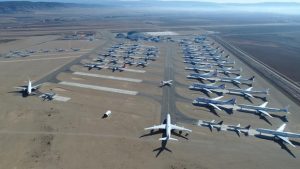Lecture given in the framework of the Amorgos International Tourist Film Festival (Greece), on 13 November 2020.
Let me start with an image.

This picture, offered by the Teruel Airport (Spain), showed an Air France Airbus A-380, the biggest passengers aircraft in Europe, rolling to its parking place.
This shocking image illustrated an article on a Spanish newspaper on Saturday April 25th, just a week after the most special Holly Week that the tourism industry will remember in decades. In those weeks, hundreds of aircrafts were being parked in European Airports such as Teruel’s, in North-East of Spain, with no date to take flight again.
During more or less the same days, I had the chance to discover a very interesting article written by the reputed Tourism Professor Francisco Dias from the Istituto Politécnico de Leiria in Portugal. Francisco Dias explained that the classical “3s” Tourism Model at the end of the XXth Century should be formulated in other terms afer the covid situation. Professor Dias suggested that instead of describing a Tourism Offer based in Sun, Sea and Sand, the “new” 3s Tourism Model would describe a Slow, Small and Smart Tourism.
After weeks of thinking, I tried to link the thoughts acumulated during that special time in a graphical composition.

The pandemic has changed the way we will travel in the future. There is no doubt about it. From traveling to see the world, we will visit specific places to live unique experiences that appeal directly to us. Perhaps not all tourism will be slow, but, to survive, it will certainly have to be smart and small.
In the new context, video, turned into a global communicative koiné, will play a very decisive role.
What is Smart Tourism?
Basically, Smart Tourism is the offer consolidated through Information and Communication based tools (ICT-based tools).
To describe Smart Tourism I’ve chosen the definition provided by The European Capital of Smart Tourism and underlined some key concepts: access, IC-T based tools, environment or interconnectedness:
‘A destination facilitating access to tourism and hospitality products, services, spaces and experiences through ICT-based tools.
It is a healthy social and cultural environment, which can be found through a focus on the city’s social and human capital.
It also implements innovative, intelligent solutions and fosters the development of entrepreneurial businesses and their interconnectedness.’
Let’s face a fact.
Since 2010, we are living digital transformation caused by intelligent, interconnected systems capable of being autonomous in decision-making.
The 4th Industrial Revolution affects all the imaginable layers in our daily lives.
Taking the words of the Spanish writer Marc Vidal in a very inspiring book, “The age of humanity” (2019), “by 2025-2029, computers will reach a level of computing that will resemble the functions of the human brain. Ten years later, by 2040, computers should be able to fully improve by themselves”.
I think it’s important to analyze the economic sectors through the lenses that the 4th Industrial Revolution offers. This transformation has provoked a huge impact precisely on the Communication and the Tourism industries.
Marc Vidal suggests in his book that the tourism industry should integrate 4 elements in its daily activity:
. the IoT,
. the mass data management in big data and small data using the cloud,
. the constant interaction with users and customers, and
. the integration of all the possible mobility elements in the business model.
I think that the tourism industry should integrate this last element, mobility, in a panoramic way. This is the key point to achieve a better Customer Experience, a strategic tool for the businesses to grow in a sustainable and efficient way.
The Customer Experience, in the center
Improve the Customer Experience through digital transformation has been one of the elements underlined by María Jesús Almazor, CEO of Telefónica Spain, at the 2020 Tourism Innovation Summit (TIS) in Seville.
The tourism industry has to build new doors from which users and customers could get in conctact with the businesses. Nowadays, to have a website properly designed for mobile it’s obviusly not enough.
At a round table on digitialization and smart cities held in November 2020, Enrique Martínez Marín, the president of the State Mercantile Society for the Management of Innovation and Tourism Technologies, SEGITTUR, under the Spanish Ministry of Industry, Commerce and Tourism, pointed out that the destinations that will leave before the crisis will be those that coincide with the market’s priorities”, and in this sense, the effort for safety and sustainability will mark the future.
Nobody disputes that sustainability is one of the most required demands by consumers globally. In this sense, a study by the Boston Consulting Group (BCG) published in March 2017, predicted that respect for the environment would be one of the megatrends that would change the way organizations work, along with personalization and products and premium services, the sharing economy, data security and ethics.
To improve the customer experience is a very strategic tool for all kinds of niche tourism: from wine to luxury or film tourism.
Niche Tourism isn’t a highway to insignificance. On the contrary. Thanks to be “specialized”, “small tourism” will be a more “efficient” model.
The Travel Video and the Smart Tourism
We have drawn the scenario, but where is the travel video in this equation? Is it really important in tis new reality?
My answer is absolutely YES. Travel Video is a strategic tool for Destinations and Companies more than ever before.
Several studies confirm that video consumption has grown dramatically during the pandemic. In Spain, a study published in November 2020 by Google reveals that people spend 36’ per day watching videos at Youtube.
Obviously, people hasn’t stopped travelling during these hard months. They have travelled mentally, remembering other travels and projecting new future travels. And video has been the main lever to activate these new trips.
During this period, empathy has been essential to connect with the audiences, although the main message that all tourism brands spread in those dates, from DMOs to hotels, was that “they were available”.
A new imagery for the post covid-19 Travel Videos
Since the impact of the covid-19 pandemic, a new imagery has been created.
At the beginning of the pandemic, the destinations focused the action not in their stunning landscapes or monuments but in the travellers homes.
The destinations appeared as providers of sensations through memories or dreams for the future travellers.
To provoke the inner travel, the bridge were most of the times what I call the latte or tea “moments”.
The narrative codes had to be adapted too. Wide angles were obviously the best way to show properly the wideness of the destinations. Some brands pushed hard to find creative ways to explain in an elegant and effective way that they were concerned about social distancing. Other brands played on connectivity.
Let’s see some examples.
The hotel company Meliá created at beginning of the last summer a campaign titled “Stay Safe with Meliá”, underlining those items that could reinfoce for their audiences the sense of security.
Destinations like Faroe Islands focused on the new scenario to create a disruptive tourism product. That’s the case of Remote Tourism, a very particular way to discover their landscapes.
Travel Video will save Smart Tourism… and Documentary will do its part!
All these new trends, in my opinion, are provoking what I suspect that will be deep consequences in the relationship between audiovisual and the travel industry.
a) Soft persuasion is built increasingly in a more complex way. Viewers are invited to take part in the preservation of the environments visited in very interesting and not invasive ways.
One of the best examples in the recent years in using video for soft persuasion is the film “Tubbataha, a National Treasure”, a short documentary film on the Tubbataha Reefs Natural Park, a UNESCO-inscribed World Heritage Site in the Philippines. Tubbataha is recognized for its outstanding universal value in the conservation of marine biodiversity and for its exceptional beauty.
This film is screened in the boat that brings tourists to Tubbataha. It has the capacity of persuade in a very soft and powerful way.
b) New narratives with a very personal style are emerging in travel video all over the world. They are cinematic in a major way. 3 very interesting examples of new narratives in Travel video are films as Chikahiro Hanamura’s Seeing Differently, a series of 3 videos produced for the Kansai Tourist Board, or the independent travel videos The Nameless Call from the Italian team Wow Tapes or Ritornare, from Christof Schuerpf.
c) True originality is being achieved in some films that understand that viewers control the representation codes and expect intelligent ways of communicating from the brands, even the tourism ones. An unbeatable example of that is the French film Staycation, awarded in several CIFFT Film Festivals.
I firmly believe that Travel Video will Save Smart Tourism, the tourism committed to digital transformation to improve the experience of its customers and contacts.
In this scenario, Documentary is playing an important role. The feature documentary film “Formentor, the Sea of Words”, directed y the filmmaker José Luis López-Linares and produced by Morena Films for Barceló Hotels, is a clrear example of how Tourism is taking advantage of Documentary Cinema to show the inner values of the industry. In this film- we can celebrate the people responsible for creating economic and cultural value by promoting tourism.
And guess what? Thanks to this film, viewers from all over the world will be ready to travel to Formentor and re-visit the incredible stories inside this Spanish iconic hotel once pandemic is finished.


 Català
Català Español
Español